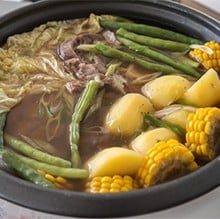Beef Recipes for Nose to Tail Cooking
Add a twist to well-loved beef recipes by using ingredients you don’t normally use. Here, we tackle the practical and efficient way to maximize your cow: Nose to Tail cooking!

Nose-to-Tail cooking has now become a global movement – a culinary trend sought after by chefs and diners for two main reasons: the need to be adventurous with their food, and because of the growing consciousness against food wastage.
The concept behind this innovative cooking method revolves around using different tissues from the slaughtered animal – not just limited to muscle meat. This includes inner organs like the kidney, heart, intestines, and the like. You can even include the “odd bits” like the blood, tail or even the chicken’s comb! Although nose to tail cooking started from the West, some Asian countries have practiced it through generations – Chinese cuisine is one of the most particular examples. With nose-to-tail cooking, you minimize costs and at the same time expand your cooking repertoire.
Nose to Tail cooking may not be every diner’s first choice, but with the right ingredients and brilliant recipes, you can create a star-worthy dish!
Join the Nose-to-Tail global movement and excite your diners with something adventurous by using these 6 parts of a cow you probably didn’t think you could use. We even include some easy recipes that will get your innovative juices flowing.

1. Beef Bones
These parts still have some untapped beef flavours, which means you could use them in making a rich beef stock for soups, as a demi-glace when cooked further, and even to flavor stews! You can even use them to make bone broth, a more viscous, collagen-rich that is slow-cooked for richer flavors. Bone broth, which is more gelatinous compared to stock, can be used in stuffing, gravy, stews, soups and sauces too. You can even use it in smoothies for those who are lactose-intolerant, and in cocktails for an added boost of protein!

2. Tongue
Beef tongue is surprisingly high in fat and preparing this part may require a lot of work, but it adds a unique texture that will delight your patrons. Plus, it comes loaded with iron and zinc, making it nutritious to boot! To prepare, first boil it in water together with onion and spices until it softens. Afterwards, remove the skin. Spanish and Philippine cuisine have several beef recipes that use beef tongue in stews, such as Lengua Estofado – beef tongue cooked in tomato sauce, or simply Lengua cooked in a cream-based mushroom sauce. Countries like Russia, on the other hand, include it in salads or serve it with chrain, a spicy horseradish paste.

3. Tail
This gelatinous meat is usually cooked in soups and stews. Traditionally, the oxtail is slow cooked, and left to simmer for long hours. Soups which make use of oxtail are popular in Asian Cuisine, particularly in China, Indonesia and Korea. In Korean cuisine, the soup is called kkori gomtang – a thick soup seasoned with salt. It pairs well with a warm bowl of rice too! The Filipinos, on the other hand, use oxtail to make Kare-kare, a stew with a savoury peanut sauce.

4. Offal Meat
Another controversial ingredient, as some cultures treat it as taboo because it is thought to be unclean. On the other hand, others use these parts to create gourmet dishes. Offal refers to the organ meats, or the internal organs and entrails of the cow, excluding the muscle and bone.
Take for example foie gras, pate and sweetbreads. There are surprisingly many uses for offal meats, such as the intestines for sausage casing, the liver for sauces and spreads, or even the heart for stews.

5. Bone Marrow
Bone marrow is soft, buttery and savoury – the kind of melt in your mouth yummy goodness that your patrons will surely love. The marrow refers to the soft fatty part in the bone that you scrape off. It comes with many health benefits when consumed, which include strengthening the immune system, repairing wounds and helping with digestion. It can be added in soups, just like the Filipino-style Bulalo, or grilled and served alongside bread or other viands.

6. Blood
Blood can be used in cooking a wide variety of dishes, from stews to becoming fillers for sausages. When cooked, it becomes congealed, making it a good thickener for soups and sauces as well. Blood Sausages are a popular way to use this ingredient. It uses of blood, which is then combined with a filler and cooked until they are thick enough. The French call it boudin noir, while the Koreans call it sundae.
Try out the following Beef Recipes in your menu today!

Lengua Pasta
Beef Tongue, or lengua, becomes the star in this Spanish-Italian fusion dish. The Lengua slices are then cooked in a Creamy White Sauce with Mushrooms, which is mixed together with Fettuccine pasta.

Beef Bulalo
Beef Bulalo is a Filipino soup dish which makes use of beef shanks and marrow bones as the main ingredients. These are cooked along with vegetables like corn until the collagen from the marrow melts into the soup.

Minced Beef Goat’s Cheese and Bell Pepper Lasagna Roll Ups
Like all easy dinner recipes, this one is hassle-free and easy to prepare. It takes inspiration from the classic Italian Lasagna. A mix of tomato sauce, minced beef, bell peppers, onions and garlic will then be spread on a cooked lasagna sheet and rolled up. These rolls will then be placed on a baking dish, topped with a Bechamel Sauce made with Mushroom Soup. Top with some goat’s cheese and pop it in the oven for a gooey, creamy delight.